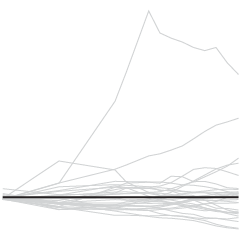How long does it take to burn off the calories from a Big Mac and medium fries or a chocolate chip cookie? Petra Axlund of 5W Infographics shows with this infographic how long you have to exercise, after eating a certain item, to burn it all off.
The red outside track shows the number of calories from the food item, while the inside tracks represent how long it takes for a male or female to burn off those calories with different exercises.
Percentage Problem
While creative, and as they say, visually appealing, it doesn’t quite work technically speaking. The primary purpose of this graphic is to compare how long it takes to burn off the calories of a food item with different exercises. However, arc lengths are formed by percentage of an undefined whole, as opposed to count (in this case, calories on the outside and minutes out the outside).
Okay, that last paragraph probably made no sense. Let’s look at an example. This issue is most evident in pizza section. According to the graphic, it takes the average male 352 minutes to burn off a pepperoni pizza while it takes just 234 minutes to run it off. Therefore, the running arc for male should be about 2/3 the size of the walking arc if it were a bar chart.
Instead we’re comparing percentages, and the running arc sorta looks like it’s about 3/4 the size of the walking arc. It’d probably look different if you were to roll out the arcs into bars, but that’s too much brain power for me. I’m lazy like that.
How it Could’ve Worked
I think there’s another way to make this graphic work other than making a bunch of bar charts. Instead of graphing minutes to burn off x amount of calories, show number of calories burned after x hours of exercise. It’d still be a little weird and less colorful, but it’d be more informative and easier to compare. It’s mostly eye candy and a one-way reference as it is now.
Gosh, I hate to be so critical, but it just doesn’t work for me. What do you think?
[via metrobest]









 This is a guest review by Peter Robinet of
This is a guest review by Peter Robinet of 
 There’s a lot of
There’s a lot of 
 Visualize This: The FlowingData Guide to Design, Visualization, and Statistics (2nd Edition)
Visualize This: The FlowingData Guide to Design, Visualization, and Statistics (2nd Edition)










